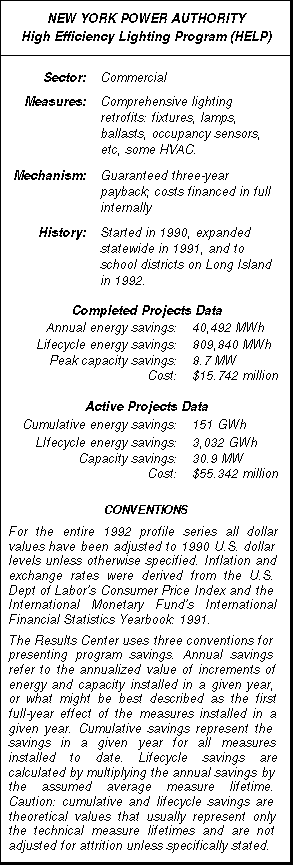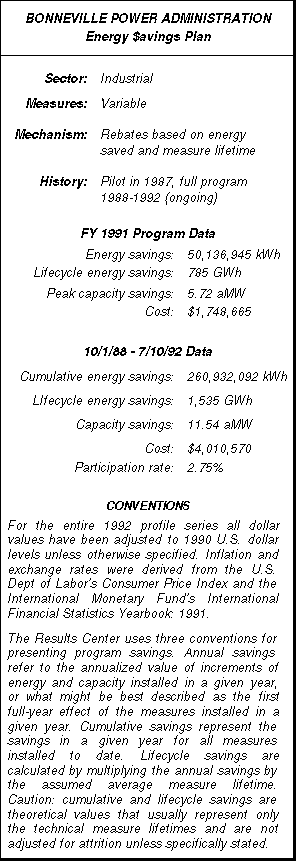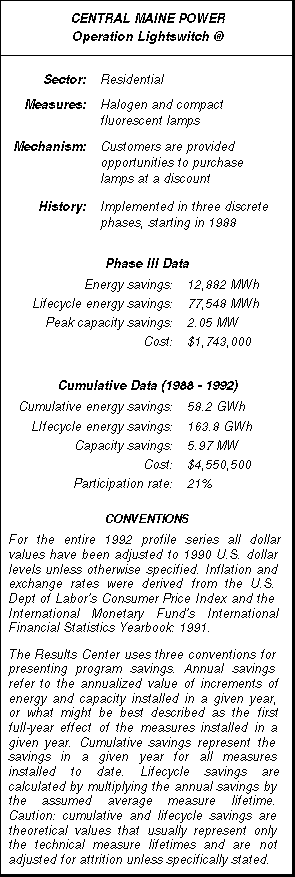EXECUTIVE SUMMARY
 As "the Chairman's baby," the New York Power Authority's (NYPA) High Efficiency Lighting Program (HELP) is one of the most aggressive programs of its kind. NYPA began the program in June 1990 for its retail customers in Southeast New York (SENY). Now the program has been expanded to government facilities statewide, and to schools on Long Island, New York.
As "the Chairman's baby," the New York Power Authority's (NYPA) High Efficiency Lighting Program (HELP) is one of the most aggressive programs of its kind. NYPA began the program in June 1990 for its retail customers in Southeast New York (SENY). Now the program has been expanded to government facilities statewide, and to schools on Long Island, New York.
To date, in the SENY region alone, over one hundred million dollars have been committed to the program and annual energy savings achieved to date with gross expenditures of $15.7 million are 40.5 GWh and 8.7 MW. When all SENY projects in various stages of completion are considered, the total cost (NYPA's share plus the customer's share) of more than $55 million, will result in annual energy savings of 151 GWh and 30.9 MW.
NYPA's HELP is a turnkey program that is offered to NYPA customers, to government facilities, and to schools on Long Island at no risk and with no cash outlay. In addition to providing consulting services for customers to analyze lighting loads and potentials for energy efficiency, NYPA will guarantee a three-year payback on its retrofits and will finance entire retrofits through its Conservation Loan Bank. Loan payments are recouped through customers' monthly bills. NYPA oversees the whole job from start to finish, from audit to installation and inspection, providing the customer with a high degree of service.
To date, the Power Authority has burst beyond its initial projections for the program for both savings and expenditures. Sixteen months into the program, over 50% of the five-year SENY budget was committed and over 50% of the five-year projected savings were identified through about 140 facility audits. By June 1990, SENY audits had identified 32 MW and associated energy savings of 157 GWh annually with an associated project cost of $53 million. These installations will be complete by the end of 1993. To date over $25 million has been formally committed to the project representing 85 retrofits that will save 17 MW and 80 GWh annually.[R#10]
The statewide HELP program, which began in earnest in June 1991, has also logged impressive results. As of September 1992 audits had been performed at 45 facilities and 14 MW of peak demand and 60 GWh of annual savings potential had been identified at a total project cost (including investor-owned utilities' rebates) of $20 million. The Long Island School program is also on track, having begun in January 1992, with 70 facilities audited revealing savings of 6 MWp and 14 GWh at a cost of more than $9 million.
[CLICK HERE TO DOWNLOAD THE ENTIRE 18 PAGE PROFILE IN PDF FILE FORMAT]
This profile was produced by

 The Energy $avings Plan provides energy reviews of industrial facilities, payments for conservation acquisitions, and rebates for the purchase of energy-efficient motors. One of the E$P's most unique features is its adaptability to many areas. It is not a formally defined program but rather a collection of principles which define conservation acquisitions that the Bonneville Power Administration would like to make in its industrial sector. The program is implemented by BPA's area offices and by utilities that receive firm power service from BPA. Each implementing agency interprets the E$P principles to create a DSM program that best suits its service territory.
The Energy $avings Plan provides energy reviews of industrial facilities, payments for conservation acquisitions, and rebates for the purchase of energy-efficient motors. One of the E$P's most unique features is its adaptability to many areas. It is not a formally defined program but rather a collection of principles which define conservation acquisitions that the Bonneville Power Administration would like to make in its industrial sector. The program is implemented by BPA's area offices and by utilities that receive firm power service from BPA. Each implementing agency interprets the E$P principles to create a DSM program that best suits its service territory. Central Maine Power's Operation Lightswitch® has been a program characterized by three discrete phases and is a powerful example of a program that has evolved from one of limited effect to quite significant effect, and perhaps most importantly has begun to transform the market for residential energy-efficient lighting in the State of Maine. While compact fluorescent lamps were all but non-existent in Maine a few years ago, now they are commonly on the retail store shelves at relatively low prices. Furthermore, 25% of the program's participants say that they will now buy the energy-efficient, compact fluorescents without any utility incentives at all!
Central Maine Power's Operation Lightswitch® has been a program characterized by three discrete phases and is a powerful example of a program that has evolved from one of limited effect to quite significant effect, and perhaps most importantly has begun to transform the market for residential energy-efficient lighting in the State of Maine. While compact fluorescent lamps were all but non-existent in Maine a few years ago, now they are commonly on the retail store shelves at relatively low prices. Furthermore, 25% of the program's participants say that they will now buy the energy-efficient, compact fluorescents without any utility incentives at all! "In some ways, Seattle is an Ecotopia," noted a Seattle City Light official, an Ecotopia where a long term commitment to low income weatherization is possible and a successful track record has indeed been proven. In addition to Seattle's progressive orientation, Seattle City Light has benefitted from Bonneville Power Administration's Energy Buy Back Program, whereby the utility's cost for conservation programs is partially offset by BPA's acquisition of conservation resources throughout the Northwest region.
"In some ways, Seattle is an Ecotopia," noted a Seattle City Light official, an Ecotopia where a long term commitment to low income weatherization is possible and a successful track record has indeed been proven. In addition to Seattle's progressive orientation, Seattle City Light has benefitted from Bonneville Power Administration's Energy Buy Back Program, whereby the utility's cost for conservation programs is partially offset by BPA's acquisition of conservation resources throughout the Northwest region.